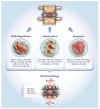MicroRNAs in Intervertebral Disc Degeneration, Apoptosis, Inflammation, and Mechanobiology
- PMID: 32443722
- PMCID: PMC7279351
- DOI: 10.3390/ijms21103601
MicroRNAs in Intervertebral Disc Degeneration, Apoptosis, Inflammation, and Mechanobiology
Abstract
Intervertebral disc (IVD) degeneration is a multifactorial pathological process associated with low back pain, the leading cause of years lived in disability worldwide. Key characteristics of the pathological changes connected with degenerative disc disease (DDD) are the degradation of the extracellular matrix (ECM), apoptosis and senescence, as well as inflammation. The impact of nonphysiological mechanical stresses on IVD degeneration and inflammation, the mechanisms of mechanotransduction, and the role of mechanosensitive miRNAs are of increasing interest. As post-transcriptional regulators, miRNAs are known to affect the expression of 30% of proteincoding genes and numerous intracellular processes. The dysregulation of miRNAs is therefore associated with various pathologies, including degenerative diseases such as DDD. This review aims to give an overview of the current status of miRNA research in degenerative disc pathology, with a special focus on the involvement of miRNAs in ECM degradation, apoptosis, and inflammation, as well as mechanobiology.
Keywords: ECM; MMP; annulus fibrosus; cartilaginous endplate; degenerative disc disease; miRNA; nucleus pulposus; senescence.
Conflict of interest statement
The authors declare no conflict of interest.
Figures


References
-
- Livshits G., Popham M., Malkin I., Sambrook P.N., Macgregor A.J., Spector T., Williams F.M. Lumbar disc degeneration and genetic factors are the main risk factors for low back pain in women: The UK Twin Spine Study. Ann. Rheum. Dis. 2011;70:1740–1745. doi: 10.1136/ard.2010.137836. - DOI - PMC - PubMed
Publication types
MeSH terms
Substances
Grants and funding
LinkOut - more resources
Full Text Sources
Research Materials

